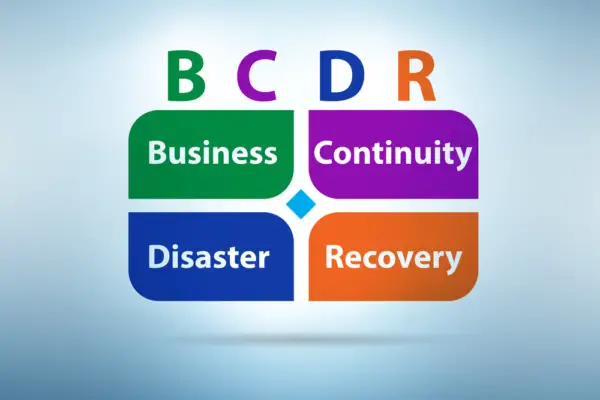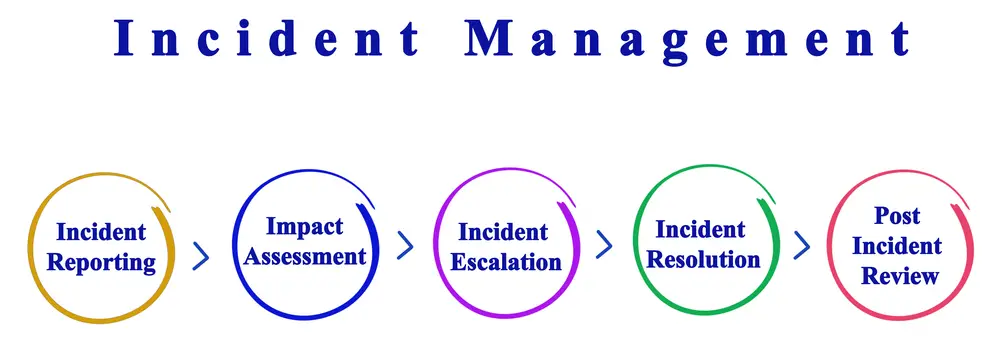Our increasingly complex and interconnected world presents a plethora of challenges and risks that can disrupt normal operations for organizations. Whether facing natural disasters or cyberattacks, businesses must stay prepared to handle various incidents and ensure smooth operations.
In this article, we delve into the key aspects of business continuity and incident management, incident response, disaster recovery, business operations, business continuity plan, business continuity planning, and business continuity plans.
Additionally, we explore best practices, tools, and techniques, as well as demonstrate their importance and benefits.
A Business Continuity Plan (BCP) outlines the steps an organization should take to ensure business continuity in the event of disasters, crises and disruptions. It includes comprehensive strategies and measures to keep the business running smoothly, with minimal damage and disruption to operations.
Incident Response (IR) is the process of managing incidents or crises when they occur. It involves taking immediate action to respond to the incident while working on the long-term plans to prevent the same incident from happening again.
Disaster Recovery (DR) involves restoring critical infrastructure and IT systems used by the organization in the event of a disaster or crisis.
Business Operations refer to the daily activities of an organization, including its employees, technology infrastructure, and business processes.
Business Continuity Planning involves creating a business continuity plan which includes the policies and procedures that enable an organization to continue operating during and after a disaster or disruption.
Business Continuity Plans are the strategies and measures outlined in the business continuity plan that enable the organization to continue operations in the event of a crisis or disruption.
There are several key steps that organizations can take to ensure business continuity and effective incident management. First, they can conduct a thorough business impact analysis to identify potential risks and challenges that could cripple business operations.
This analysis should consider various scenarios such as natural disasters, cyber attacks, pandemics, and power outages.
Once identified, organizations should implement appropriate measures to mitigate the likelihood of these disasters and crises.
These measures could include creating remote work policies, disaster recovery technology infrastructure, and business continuity plans that outline how operations will function in the event of a crisis or disruption.
Regular drills and training exercises can help to ensure that teams are prepared to react quickly and efficiently during an incident. Simulate crisis scenarios, teams can identify gaps in the plan and fine-tune their response processes.
Furthermore, having an effective communication system in place is crucial during a crisis or disruption. A reliable communication system can help to ensure that employees, clients, and stakeholders are informed and updated throughout the incident.
Several organizations have taken proactive measures to ensure business continuity and effective incident management. In the wake of the COVID-19 pandemic, many companies pivoted their operations online.
Companies with well-developed business continuity plans were able to adapt and continue operations, while others struggled to recover from the pandemic’s impact.
Business continuity and incident management are crucial for organizations that need to ensure consistent operations and continuity in the event of disruptions. Develop effective business continuity plans, implementing mitigation measures, conducting regular drills, and investing in reliable communication systems.
Organizations can equip themselves to respond effectively in a crisis. The key is having a plan in place and regularly assessing and adjusting the plan according to evolving threats and risks.

1. Protecting critical business functions
Business continuity planning is all about ensuring that essential business functions can continue in times of crisis. A business continuity plan defines the essential functions that are critical to operations, and then outlines how to maintain those functions in the event of a disaster or significant disruption.
A robust business continuity plan, enterprises can identify and prioritize critical business functions, and protect them from any harm that may arise.
2. Maintaining customer trust
When businesses cannot operate during unexpected events, it can damage customer relationships and harm a company’s reputation. By implementing comprehensive business continuity and incident management plans, organizations can demonstrate that they can function effectively during difficult times and keep operations running with minimal interruptions.
This, in turn, can instill confidence in customers, suppliers, and other stakeholders, while strengthening the trust they have in the company’s resilience and dependability.
3. Regulatory compliance
Many industries have strict regulatory requirements that companies must adhere to, and these requirements often require businesses to have a business continuity plan in place. It’s not just about compliance; it’s about protecting customers, employees, and stakeholders from harm in the event of a crisis.
Organizations that fail to comply with these regulations face penalties, legal action, and irreparable reputational damage.
4. Minimizing downtime and costs
An unexpected event can lead to downtime and, as a result, lost revenue. With a robust business continuity plan in place, businesses can minimize disruption-related downtime and reduce the impact of that downtime on the bottom line.
It’s much more cost-effective to invest in measures that will prevent potential disruption or reduce their impact than to deal with the full extent of the damage in the aftermath of an incident.
5. Agile response to change
Business continuity planning is not just about reacting to crises; it’s about implementing an agile approach to change. The COVID-19 pandemic has exposed the many areas where companies may be vulnerable to unexpected business disruptions. Business continuity and incident management planning can help organizations proactively identify and minimize these vulnerabilities, creating a more resilience business that can adapt more effectively to a changing environment.
Business Continuity and Incident Management: A Crucial Integration
Organizations must prioritize business continuity and incident management to effectively respond to unexpected events and minimize their impact on operations. Incident management identifies, analyzes, and resolves incidents, while business continuity maintains stable operations during and after a disruptive event.
Merging these two practices, organizations enhance their preparedness and response to incidents and disruptions, ensuring a quick and effective recovery.
Benefits of Integrating Business Continuity and Incident Management
The integration of BC and IM can bring several benefits to an organization, including:
• Improved Preparedness: Integrating BC and IM can provide greater preparedness for unexpected incidents and crises. This integration allows for a comprehensive approach to risk management, from prevention to response and recovery.
• Increased Efficiency: Combining BC and IM means consolidating plans, processes, and procedures, which will reduce duplication of effort and enhance efficiency.
• Better Communications: Clear, robust communication is essential during an incident. Integrating BC and IM enables efficient communication and ensures the right message is delivered to the right people at the right time.
• Reduced Downtime: By integrating BC and IM, organizations can reduce downtime during incidents. BC and IM plans work together to ensure that the essential business functions continue with minimal disruption.
Challenges to Integrating Business Continuity and Incident Management
Integrating BC and IM is not always easy and can face challenges in implementing an effective integrated model. One of the challenges can be conflicting objectives with different priorities. BC involves planning for the long-term continuity of the organization, while IM aims to respond quickly and minimize the effects of an incident.
However, these challenges can be overcome by an effective integration strategy, which brings together the processes, procedures, and tools related to both BC and IM.

Keys to Successful Integration of Business Continuity and Incident Management
Successful integration of BC and IM requires a strategic and systematic approach, which includes the following essential keys:
• Senior Management Support: The commitment of senior management is crucial to ensure that the integration of BC and IM is successful. It is essential to secure the necessary resources and provide the required support to implement the integration strategy.
• Collaboration: Collaboration between the BC and IM teams is necessary to ensure effective integration. Regular communication, sharing information, and consultation are vital to achieving this collaboration.
• Standardization: Standardization of plans, processes, and procedures provides a consistent approach for the integration of BC and IM. This approach will enable teams to work together effectively and efficiently.
Incident Response and Disaster Recovery: Essential Components of a Comprehensive Strategy
Both incident response and disaster recovery are vital elements of an all-encompassing business continuity strategy. Incident response entails the immediate actions an organization takes to address a security breach or another disruptive event, while disaster recovery focuses on restoring critical systems and data after a major incident.
A well-structured incident response and disaster recovery strategy enables businesses to rebound from unforeseen disasters and minimizes potential damage to their operations and reputation.
Business Operations: Achieving Stability and Efficiency Amid Disruptions
Organizations need to maintain stable and efficient business operations to stay competitive and successful in the face of potential disruptions. Business continuity planning plays a significant role in accomplishing this goal by identifying potential risks, assessing their impact, and developing strategies to mitigate them.
Implementing effective business continuity practices, organizations can reduce the likelihood and impact of disruptions, ensuring they can continue delivering products and services to customers even during challenging times.
Business Continuity Plan: A Vital Blueprint for Organizational Resilience
Organizations need a detailed and well-structured business continuity plan to ensure they can continue functioning despite interruptions or crises. A business continuity plan outlines the procedures and processes an organization will follow during a disruption, such as identifying critical functions and resources, establishing communication channels, and allocating roles and responsibilities.
Regularly updating and testing the business continuity plan ensures its effectiveness and relevance to the organization’s changing needs and environment.
Business Continuity Planning: A Comprehensive Strategy for Disruption Management
Business continuity planning involves developing a wide-ranging strategy to address potential disruptions and maintain business operations during and after a disruptive event. This process includes identifying potential risks, assessing their impact, and developing strategies to mitigate them.
Implementing a robust business continuity planning process, organizations can better prepare for and manage disruptions, minimizing their impact on operations and ensuring a swift recovery.
Incident Management: A Key Component of Effective Business Continuity
As a critical aspect of an effective business continuity strategy, incident management minimizes the impact of incidents on business operations. Incident management identifies, analyzes, and resolves incidents, helping organizations quickly address and mitigate the effects of disruptive events.
Incorporating incident management into business continuity plans improves organizational resilience and ensures operational continuity.
Types of Business Continuity Plans: Addressing Various Disruption Aspects
Organizations can implement various types of business continuity plans to tackle different aspects of potential disruptions. Examples include IT disaster recovery plans, crisis communication plans, and emergency response plans.
Develop and implement a comprehensive set of business continuity plans, organizations can ensure they are prepared for a wide range of potential incidents and maintain their operations under various circumstances.
Conclusion
In the dynamic and ever-changing business environment of today, organizations must prioritize business continuity and incident management to remain competitive and resilient. Understand the key aspects of these practices, implementing effective strategies, and regularly updating and testing their plans, businesses can minimize the impact of disruptions and ensure a swift recovery.
Following best practices, utilizing appropriate tools and techniques, and learning from case studies and examples will enable organizations to benefit from implementing comprehensive business continuity and incident management practices in their operations.

Chris Ekai is a Risk Management expert with over 10 years of experience in the field. He has a Master’s(MSc) degree in Risk Management from University of Portsmouth and is a CPA and Finance professional. He currently works as a Content Manager at Risk Publishing, writing about Enterprise Risk Management, Business Continuity Management and Project Management.



